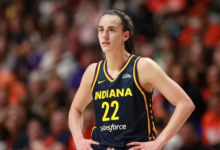What we got wrong about Caitlin Clark

There is one thing I got wrong — or at least vastly underestimated — about Caitlin Clark’s impact on the WNBA. There is also one thing that I think almost everyone got wrong about the WNBA’s reaction to Caitlin Clark and her impact on the league.
The WNBA playoffs begin Sunday — Clark’s Indiana Fever are tentatively scheduled to take on the Connecticut Sun in a best-of-three series.
Historically, the league has struggled to garner ratings or attention outside of hardcore fans, especially when facing competition from pro and college football. Last year’s finals averaged just 728,000 viewers on ESPN — actually up more than 30 percent but still a paltry number. The playoffs in general averaged just 470,000 viewers.
Not this time.
This is the Clark factor I didn’t see coming.
Was her arrival following a legendary and legendarily popular career at the University of Iowa going to bring in extra attention and some new fans? Absolutely. Clark is one of the most popular athletes in America. TV ratings, media attention, jersey sales and so on were going to pop.
That said, interest at one level of the sport doesn’t always equate to interest at the next level — or a different level. The United States women’s national soccer team has come off of World Cups and Olympic golds with lots of momentum and mega-famous stars — Alex Morgan, Hope Solo, Carli Lloyd, etc. Yet the impact on the National Women’s Soccer League has been a bounce, not a sustained spike.
While Clark’s style of play was crowd pleasing, she also benefited from some built-in factors.
First off, Iowa has a much larger fan base than any WNBA team, so she didn’t need to create Hawkeye fans when she arrived in Iowa City; she just needed to get a higher percentage of Hawkeye fans to care about women’s basketball. Secondly, most of her biggest games came against equally — or even more — popular teams … Ohio State, Indiana, Connecticut, LSU, South Carolina and so on.
Clark and Iowa became an event wherever they went. That’s different from night in, night out interest.
Then there was the draw of the NCAA tournament — the brackets, the one-and-done, the timing in March/April when the country dials in on hoops. The women’s Final Four always out-rates the WNBA.
Caitlin Clark has drawn more eyeballs to the WNBA than the league has ever seen before. (Justin Casterline/Getty Images)
The 2024 national title game between Iowa and South Carolina drew an astounding 18.9 million viewers, but how many of them would follow Clark through a prolonged regular season in the WNBA without the drama of March Madness? Would they watch some hum-drum July game?
Well, a heck of a lot of them did. The ratings growth for the WNBA this year was almost unfathomable.
ESPN reports that it averaged 1.2 million viewers for its games, up from 440,000 a year prior. By comparison, the NBA’s average rating last season for games on ESPN and TNT was 1.56 million. Some 3.44 million watched the WNBA All-Star Game vs. 5.5 million for the NBA All-Star Game.
The Fever alone garnered five games with more than two million viewers and 18 with more than a million. This wasn’t just Sunday afternoons on ABC, either.
A Friday night game on Aug. 30 against Chicago drew 1.6 million to Ion, easily the largest audience in the low-profile cable network’s history. Two games on NBATV recorded 600,000 or more viewers.
The Clark fans came and didn’t leave. They followed every game. Some of them, no doubt, began watching other teams as well. Yes, Clark was the main draw, but more people today know the brilliance of A’ja Wilson and Breanna Stewart than they did a year ago.
It suggests that while Fever playoff ratings could set new records, there may be a sustained and extended boost for all postseason games that goes far beyond any reasonable expectation — mine in particular — of what Clark was going to deliver.
Now, to the part that seemed to trouble the league and many of its fans. Clark demanded huge attention and sellouts everywhere she went. With it came some understandable resentment from the returning players and many longtime fans.
There were endless complaints that the WNBA’s players and coaches should embrace and thank Clark for what she was doing for the league. Yet in having so many push back — or sometimes literally push her down — the league became even more interesting.
The best thing that happened for everyone was the cold shoulders and hard fouls, the Olympic “snub,” and Sheryl Swoopes and TV commentators seemingly dismissing her game. The more heat came on Clark, the more her fans — and all fans — had reason to tune in to see how she would respond.
Rivalries are great for sports. Controversies sell. If Clark had been hugged and accepted and heralded, the 2024 season would have lacked the spice that has made it an even more intriguing follow.
Clark slowly adjusted to the physicality of the WNBA while her teammates adjusted to her style of play. She enters the playoffs as arguably a top-five player in the league and is now regularly scoring 25 or 30 points a game, while hitting logo threes and tossing length-of-the-court passes. That’s what drew so many to her in the first place.
No, there probably won’t be a playoff game that hits 18.9 million viewers, but Caitlin Clark hasn’t just smashed expected popularity levels as a rookie; the resistance to her and her success helped her in that pursuit.
Game 1 is Sunday — right up against the NFL. This time, a lot of people are going to watch anyway.




